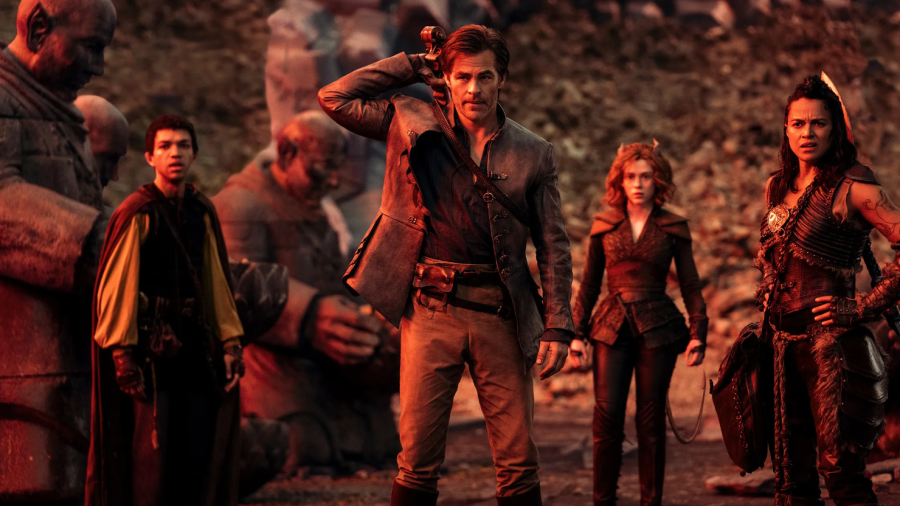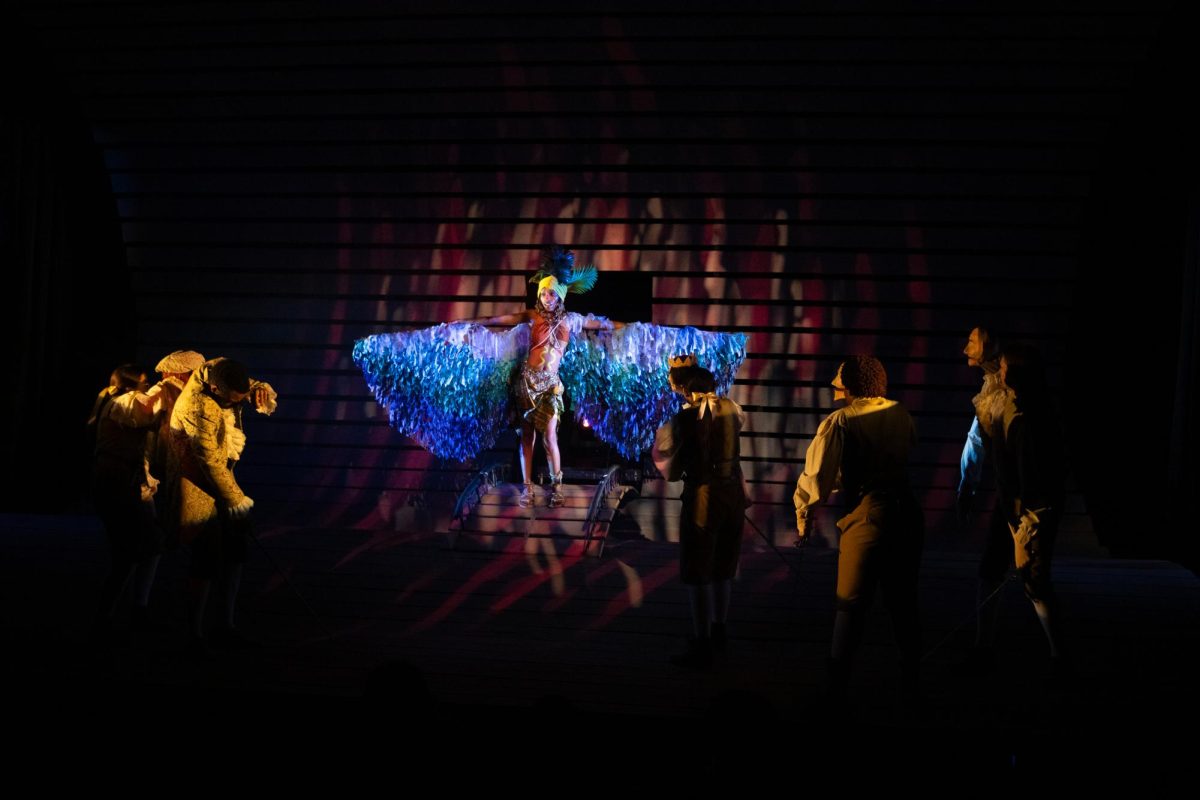How “Dungeons & Dragons: Honor Among Thieves” Compares to its Predecessors
The heroes in “Dungeons & Dragons: Honor Among Thieves” form an unlikely party. Photo credit to Paramount Pictures.
May 5, 2023
Dungeons & Dragons is a tabletop roleplaying game enjoyed by almost 50 million players worldwide today. Its growing popularity since its introduction in 1974 made it inevitable that Hollywood would eventually make an adaptation of a D&D adventure.
“Dungeons & Dragons: Honor Among Thieves” premiered on March 31, 2023, making $70.1 million worldwide in box office revenue and generating many positive reviews. The film has made a splash in online D&D circles as players opine about its successes and failures on social media.
Seasoned D&D fans will know that “Dungeons & Dragons: Honor Among Thieves” is not the first time the film industry has attempted to bring a classic D&D adventure to the big screen. An ill-fated attempt in 2000 is widely reviled by D&D fans for being unfaithful to the source material, being poorly scripted and acted, and employing bad special effects. The sequels released in 2005 and 2012 stayed more faithful to the source materials, but with budgets of only $12 million and a limited theatrical release, with the third one being released direct-to-DVD, the films were doomed from the start.
“Dungeons & Dragons: Honor Among Thieves” stayed incredibly faithful to the D&D source material. The film is set in the pre-established setting of the Forgotten Realms, which was created by Ed Greenwood in 1987 and remains one of the most detailed campaign settings of modern-day D&D. The film makes use of locations from this setting, and characters have connections to pre-established factions in the Forgotten Realms.
Though some references to the lore are superficial, the film still weaves important parts of the Forgotten Realms into the story. The iconic city of Neverwinter is the main urban setting of the film and where the climax takes place. Edgin’s connection to the Harpers, a secret organization of heroic spies, informs a significant part of his character and motivations. The villain of the film is a member of Red Wizards of Thay, an organization of evil wizards considered a staple of the Forgotten Realms rogues’ gallery. Icewind Dale, the icy tundra popularized as the main setting of the first few “Legend of Drizzt” books, appears as the location of the prison. The Underdark, also popularized by the “Legend of Drizzt”, is the setting of the second act of the film.
In addition to making use of familiar D&D settings, the film includesD&D classes and abilities. The main party consists of a bard, a barbarian, a sorcerer, a druid, and a paladin. A rogue and several wizards oppose them. Many of their abilities call back to D&D game mechanics, such as the druid’s Wild Shape ability, which allows her to transform into different animals.
The writers also clearly flipped through the “Monster Manual”, as the party finds themselves facing a displacer beast, a gelatinous cube, and a mimic, all brought to life with impressive practical and digital effects from Industrial Light & Magic, a visual effects company owned by Lucasfilm. The film also features two dragons, a classic fire-breathing red dragon that the party faces in the Underdark in an homage to the balrog fight from “Lord of the Rings”, and a lesser-known, acid-spitting black dragon featured in a flashback.
One of the most impressive feats of the practical effects is the druid’s owlbear form. The owlbear, which is a combination between an owl and a bear, is a creature unique to D&D.
“The animators concentrated on giving the beast personality and conveying that there’s a humanoid brain in control of all the chaos,” writes Benard Boo in a piece about the practical effects of the film.
The gelatinous cube was another challenge for the team at ILM. Even though the cube is simple in theory, it was not included in the previous D&D films.
“Nobody’s ever seen anything quite like this before on film,” said Todd Vaziri, Compositing Supervisor at ILM, who worked on the film’s effects. “We asked ourselves, well, what would it look like if humans were suspended inside a 15-foot by 15-foot cube made of gelatin?”
Artists and engineers on the team ran lots of experiments and simulations to test the physics and lighting to make sure that the cube looked like it had sprung off the pages of the “Monster Manual”.
The cast of the main adventuring party features Chris Pine as Edgin the bard, Michelle Rodriguez as Holga the barbarian, Justice Smith as Simon the sorcerer, and Sophia Lillis as Doric the druid. Regé-Jean Page plays Xenk the paladin, a guest party member featured in the second act of the movie. The film’s antagonists are brought to life by Hugh Grant as Forge the rogue and Daisy Head as Sofina the wizard. The entire cast gave entertaining but grounding performances. Despite the many quips thrown around in various scenes, the actors knew when to dial back to keep somber, sincere scenes grounded, without breaking the overall light-hearted tone of the film. Head in particular gives a chilling performance as the powerful, undead wizard and final boss the party faces in the quest.
“John [Francis Daley] and Jonathan [Goldstein] never sacrificed character for the plot […] I think we’re slowly creeping into an age where people don’t just want spectacle, they also want heart,” said Justice Smith in an interview.
Ultimately, this pinpointed something that this film had that the previous three D&D movies lacked: compelling characters. The characters of “Dungeons & Dragons: Honor Among Thieves” are already becoming iconic D&D characters, thanks in no small part to both the writers who crafted the characters and the actors that brought them to life by finding the careful balance between their flaws, their personality traits, and the character’s bonds with each other.
Another important component of the film is its script and story. The story was largely crafted by the directors, John Francis Daley and Jonathan Goldstein.
“Ours is a movie that doesn’t take itself with great seriousness, but it’s never a spoof. It honors the world of D&D and celebrates it,” said Goldstein.
He elaborates that influences on the film include “The Princess Bride”, “Monty Python and the Holy Grail”, and “The Lord of the Rings”. The film is comparable to a heist movie with some “dungeon crawling” aspects, and contains a genuinely heartfelt twist at the end that pays tribute to a strong platonic relationship developed over the course of the story.
Despite its many successes, the film does have several shortcomings in regard to how it adapted D&D lore. Edgin the bard is unable to cast spells despite bards typically being a full caster class in the game. In fact, his quick thinking and thievery skills portray him closer to a non-combatant rogue who just happens to play a musical instrument. Doric the druid turns into an owlbear multiple times during the film, which is impossible for druids according to typical D&D game mechanics (though it is frequently allowed through homebrew rules).
Instances like these were noticed and commented on by D&D players, but they tend to agree that these deviations don’t take away from the overall excellence. It is clear that the film has excelled in every part that its predecessors lacked.
“Dungeons & Dragons: Honor Among Thieves” was able to combine Dungeons & Dragons lore and gameplay with a fantastic script and cast, but it didn’t isolate an average moviegoer who had no prior knowledge of D&D.
“Writers and directors John Francis Daley and Jonathan Goldstein emphasize lighthearted entertainment that lifts ‘Honor Among Thieves’ above cumbersome lore,” IGN writes.
“Fun, humorous, with some good action and adventure, it evokes well a good session at a table,” said Matthew Mercer, a “Critical Role” cast member and a well-known figure in online D&D spaces. He gave the film the highest praise a seasoned D&D player could give the film: a good round of D&D at a table.









